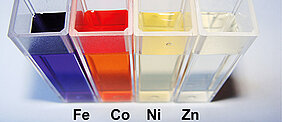Molecular Lego
07/20/2017They can change colour, vary their spin or go from solid to liquid state: Certain polymers have fascinating properties. Researchers from the University of Würzburg have studied just how they do this.

Their work is a "hot paper" which covers interesting and important aspects of a new class of polymers which is presently being met with great interest due to its wide technological application potential. Such is the verdict of the publishers of Chemistry – A European Journal after reading the latest paper of Professor Dirk Kurth's team and PhD student Stefanie Munzert.
The scientists studied a specific class of polymers with the complicated-sounding name of metallosupramolecular coordination polyelectrolytes or short MEPE They have a number of interesting properties whose underlying principles have been mostly in the dark until now. The new research results from Würzburg have changed this.
Electrical voltage causes colour change
Dirk Kurth is a pioneer in the field of MEPE. He discovered the material class in the mid-1990ies and has been studying it ever since. "MEPE have extraordinary electrochromic properties," he explains. This means that when applying a low voltage of a few volts to materials made of MEPE, they will change colour as a result. This makes them ideally suited for manufacturing innovative glazing, so-called smart windows.
As a component of porous solids, they are able to change their flow behaviour in the electric field. Their properties vary between liquid and virtually solid, as desired, making them suitable for mechanical engineering applications such as controllable clutches or for medical use e.g. to protect joints against high stress shortly after surgery.
Moreover, MEPE exhibit a temperature-induced spin crossover under certain circumstances. Electrons then change their spin, i.e. their direction of rotation, and along with that their magnetic moment.
Accurate predictions now possible
While these properties are crucial for technological developments, little is known about the structure and growth of this novel material class. In fact, the process of making them is pretty simple. "It's a kind of 'molecular Lego', however, with self-assembling towers," Professor Kurth explains. All the researchers have to do is add a solution of so-called terpyridine ligands to a solution of a metal salt in the laboratory – the rest will happen automatically.
But it has been unclear until recently how this process takes place, how quickly it proceeds and how it can be controlled. The publication of the Würzburg research findings has changed this, making the work a hot paper in the process. "For the first time, our results have allowed us to predict how long the respective processes take under which conditions," Dirk Kurth says. This enables researchers to define exact specifications that have to be fulfilled in order to yield a material with the desired properties.
Previously, this had been more of a trial & error approach according to Kurth. When a scientist wanted to produce a film of a specific viscosity from a solution, he or she could only guess whether this would take hours, days or weeks. Now they have a kind of "recipe" telling them exactly how to proceed to achieve the desired outcome. Additionally, Dirk Kurth and his team have discovered a simple way to accelerate the process: The MEPE grow more quickly when salt is added!
Rod-shaped aggregates under the microscope
In another first, the scientists succeeded to deliver an image of the MEPE in molecular resolution. The cooperation partners from the Weitzman Institute in Israel were responsible for this success. They "flash-froze" the MEPE solution in a manner of speaking and subsequently investigated it using an electron microscope. What they found were rod-shaped structures that can be several hundred nanometres long.
Dirk Kurth considers his work fundamental research from which technological applications can be derived. Nevertheless, he is reticent to talk about possible applications. Rather, he wants to get a deeper understanding of the goings-on. He is interested in finding out how MEPE interact with electric or mechanical fields, how they respond to external stimuli or which reactive properties MEPE have and whether they are able to trigger certain reactions, like a catalyst, and which stimuli may be required for this purpose. He intends to continue researching in this direction.
The Kinetics of Growth of Metallo-supramolecular Polyelectrolytes in Solution. Stefanie Martina Munzert, Simon P. Stier, Guntram Schwarz, Haim Weissman, Boris Rybtchinski, and Dirk G. Kurth. Chemistry – A European Journal, DOI: 10.1002/chem.201701417
Contact
Prof. Dr. Dirk Kurth, Chair for Chemical Technology of Material Synthesis, Faculty for Chemistry and Pharmacy, University of Würzburg.
T: +49 931 31-82631, dirk.kurth@matsyn.uni-wuerzburg.de






